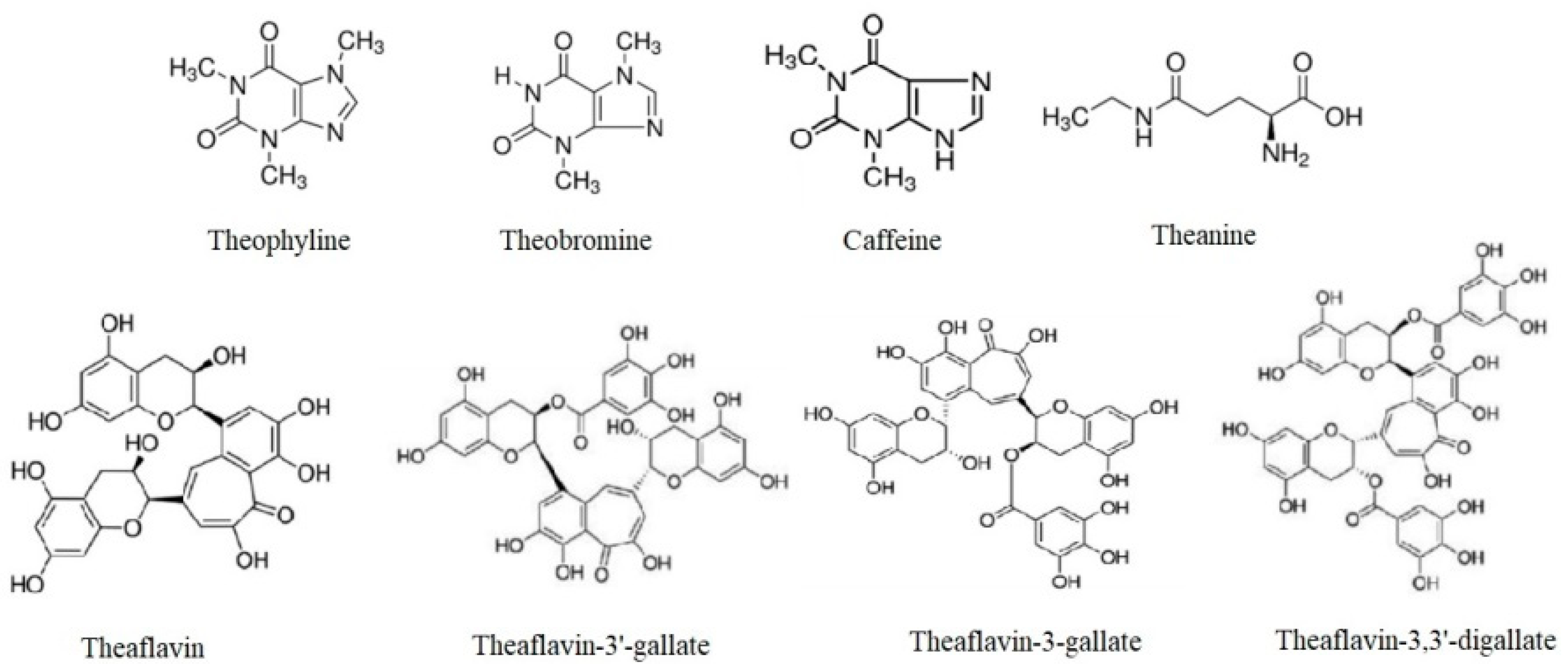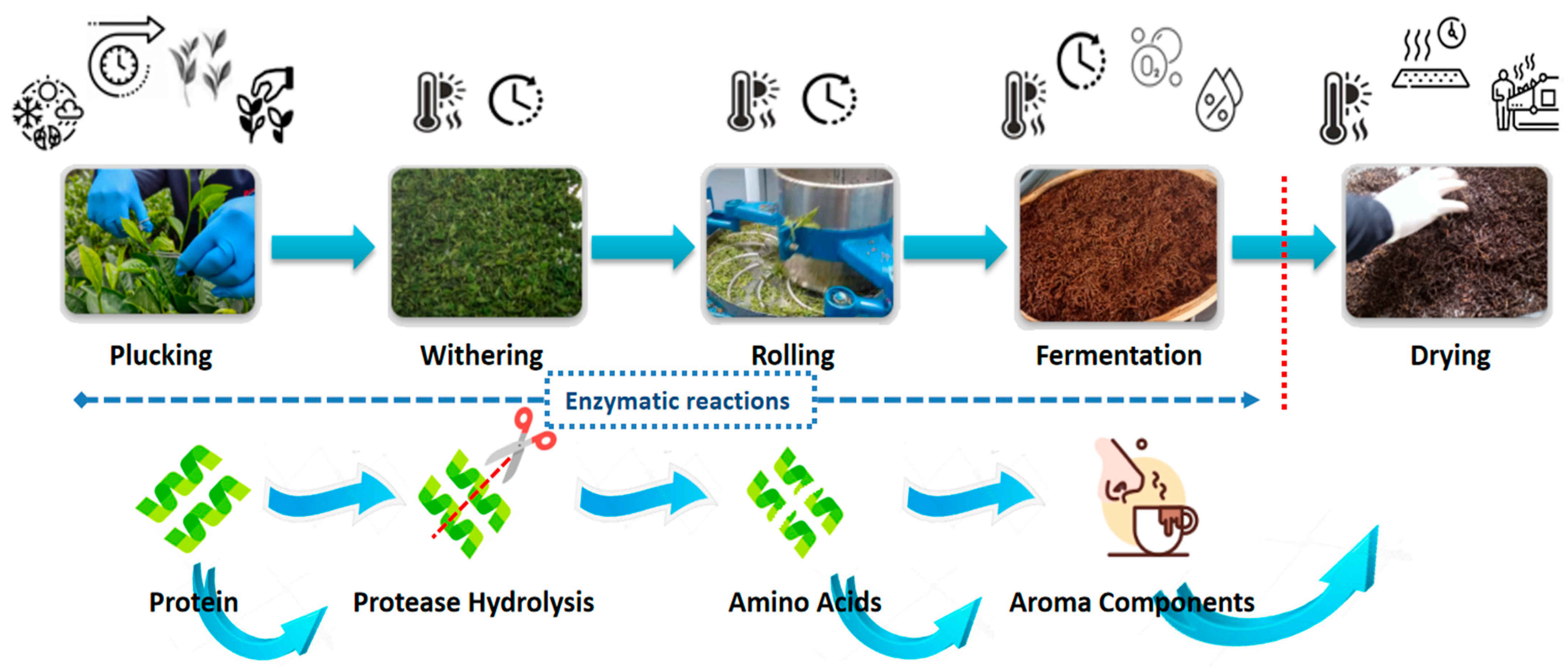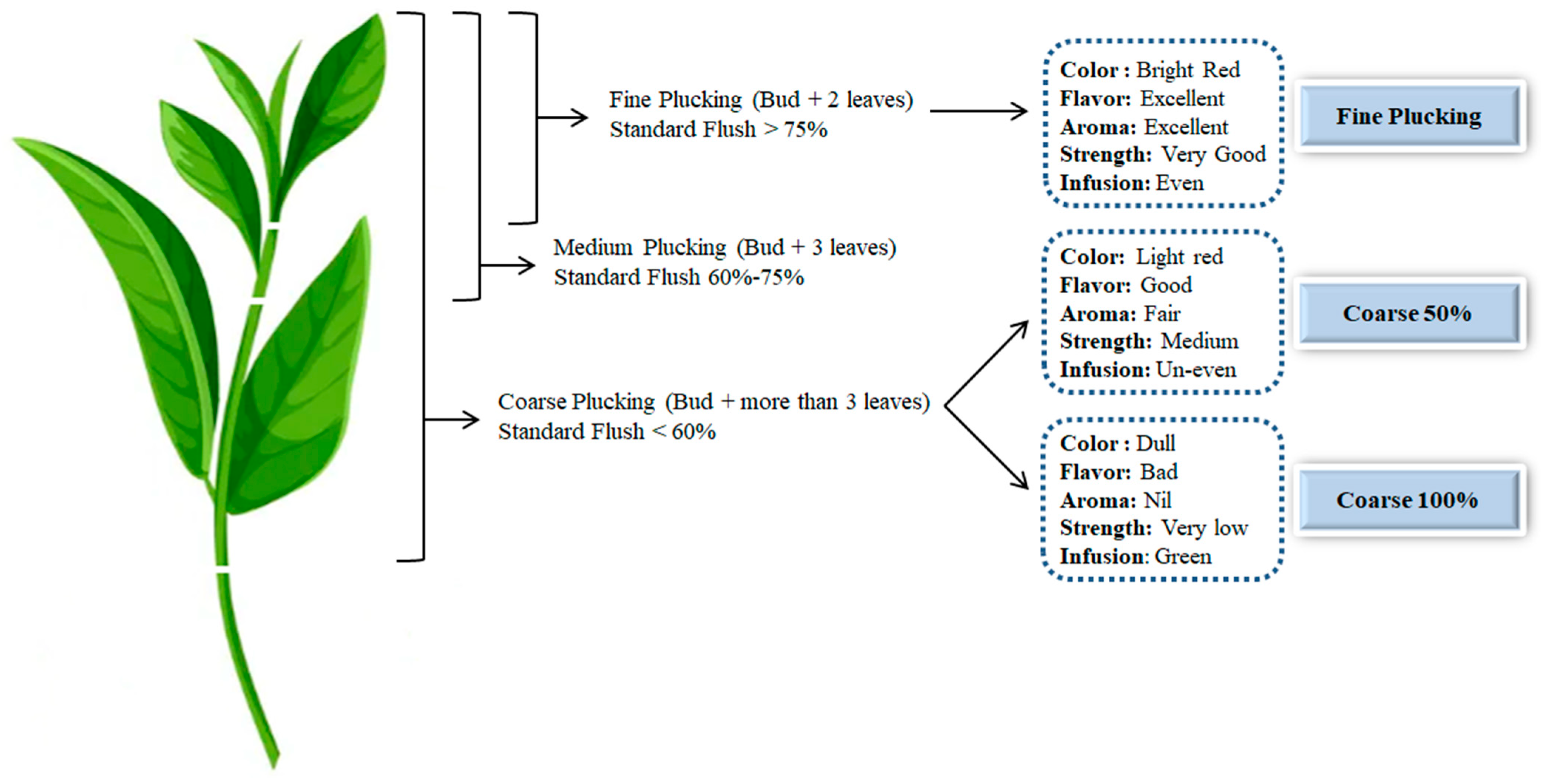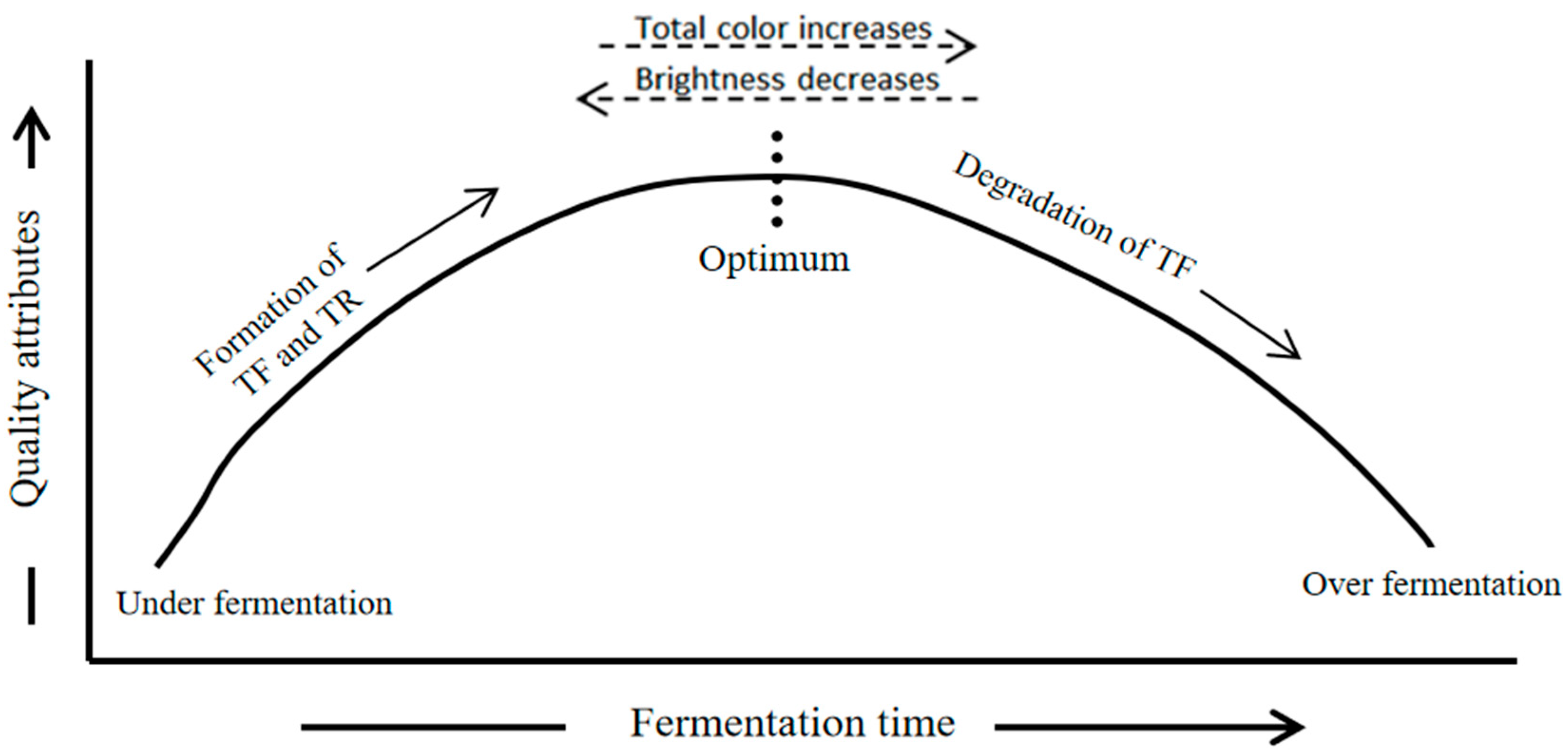
| Version | Summary | Created by | Modification | Content Size | Created at | Operation |
|---|---|---|---|---|---|---|
| 1 | Muhammad Aaqil | -- | 5764 | 2023-12-21 06:15:51 | | | |
| 2 | Lindsay Dong | Meta information modification | 5764 | 2023-12-22 03:14:53 | | | | |
| 3 | Lindsay Dong | Meta information modification | 5764 | 2023-12-29 09:39:23 | | |
Video Upload Options
Tea (Camellia sinensis) has grown for over 300 years and is recognized worldwide as among other well-renowned crops. The quality of black tea depends on plucking (method, standard, season, and intervals), withering and rolling (time and temperature), fermentation (time, temperature, and RH), drying (temperature and method), and storage conditions, which have a high influence on the final quality of black tea. At the rolling stage, the oxidation process is initiated and ends at the early drying stage until the enzymes that transform tea polyphenols into thearubigins (TRs) and theaflavins (TFs) are denatured by heat. By increasing fermentation time, TRs increased, and TF decreased. Each is liable for black tea’s brightness, taste, and color.
1. Introduction
2. Black Tea’s Health Benefits and Chemical Composition

3. Black Tea’s Manufacturing Cycle and Its Influence on Quality Characteristics

3.1. Plucking/Harvesting/Picking
3.1.1. Plucking Method
3.1.2. Plucking Standard

3.1.3. Shooting Period/Plucking Interval
3.1.4. Plucking Season
4. Withering Stage
5. Rolling/Maceration Stage
6. Fermentation/Oxidation Stage
6.1. The Influence of Fermentation Process Parameters on Black Tea’s Quality Attributes
6.2. Time

6.3. Temperature
6.4. Oxygen and Relative Humidity
7. Drying/Firing Stage
Factors Influencing the Drying Process
8. Storage Method and Duration
References
- Yang, Z.; Baldermann, S.; Watanabe, N. Recent Studies of the Volatile Compounds in Tea. Food Res. Int. 2013, 53, 585–599.
- Liu, Z.H.; Gao, L.Z.; Chen, Z.M.; Zeng, X.; Huang, J.A.; Gong, Y.S.; Li, Q.; Liu, S.Q.; Lin, Y.; Cai, S.X.; et al. Leading progress on genomics, health benefits and utilization of tea resources in China. Nature 2019, 566.
- Vuong, Q.V. Epidemiological Evidence Linking Tea Consumption to Human Health: A Review. Crit. Rev. Food Sci. Nutr. 2014, 54, 523–536.
- Zhang, L.; Ho, C.-T.; Zhou, J.; Santos, J.S.; Armstrong, L.; Granato, D. Chemistry and Biological Activities of Processed Camellia sinensis Teas: A Comprehensive Review. Compr. Rev. Food Sci. Food Saf. 2019, 18, 1474–1495.
- De Silva, M.S.D.L. The Effects of Soil Amendments on Selected Properties of Tea Soils and Tea Plants (Camellia sinensis L.) in Australia and Sri Lanka. Ph.D. Thesis, James Cook University, Queensland, Australia, 2007.
- Panda, B.K.; Datta, A.K. Quantitative Analysis of Major Phytochemicals in Orthodox Tea (Camellia sinensis), Oxidized under Compressed Air Environment. J. Food Sci. 2016, 81, C858–C866.
- Li, X.; Xie, C.; He, Y.; Qiu, Z.; Zhang, Y. Characterizing the Moisture Content of Tea with Diffuse Reflectance Spectroscopy Using Wavelet Transform and Multivariate Analysis. Sensors 2012, 12, 9847–9861.
- Tran, J. Green Tea: A Potential Alternative Anti-Infectious Agent Catechins and Viral Infections. Adv. Anthropol. 2013, 3, 198–202.
- Pou, K.R.J. Fermentation: The Key Step in the Processing of Black Tea. J. Biosyst. Eng. 2016, 41, 85–92.
- Muthumani, T.; Kumar, R.S.S. Influence of Fermentation Time on the Development of Compounds Responsible for Quality in Black Tea. Food Chem. 2007, 1, 98–102.
- Zhu, K.; Ouyang, J.; Huang, J.; Liu, Z. Research Progress of Black Tea Thearubigins: A Review. Crit. Rev. Food Sci. Nutr. 2021, 61, 1556–1566.
- Astill, C.; Birch, M.R.; Dacombe, C.; Humphrey, P.G.; Martin, P.T. Factors Affecting the Caffeine and Polyphenol Contents of Black and Green Tea Infusions. J. Agric. Food Chem. 2001, 49, 5340–5347.
- Sharangi, A.B. Medicinal and Therapeutic Potentialities of Tea (Camellia sinensis L.)—A Review. Food Res. Int. 2009, 42, 529–535.
- Yan, S.-H. NIR Evaluation of the Quality of Tea and Its Market Price. Spectrosc. Eur. 2007, 19, 16–19.
- Bhattacharya, U.; Halder, B.; Mukhopadhyay, S.; Giri, A.K. Role of Oxidation-Triggered Activation of JNK and P38 MAPK in Black Tea Polyphenols Induced Apoptotic Death of A375 Cells. Cancer Sci. 2009, 100, 1971–1978.
- Persson, I.A.-L.; Josefsson, M.; Persson, K.; Andersson, R.G.G. Tea Flavanols Inhibit Angiotensin-Converting Enzyme Activity and Increase Nitric Oxide Production in Human Endothelial Cells. J. Pharm. Pharmacol. 2006, 58, 1139–1144.
- Yang, Z.; Tu, Y.; Xia, H.; Jie, G.; Chen, X.; He, P. Suppression of Free-Radicals and Protection against H2O2-Induced Oxidative Damage in HPF-1 Cell by Oxidized Phenolic Compounds Present in Black Tea. Food Chem. 2007, 105, 1349–1356.
- Ye, F.; Qiao, X.; Gui, A.; Wang, S.; Liu, P.; Wang, X.; Teng, J.; Zheng, L.; Feng, L.; Han, H.; et al. Metabolomics Provides A Novel Interpretation of the Changes in Main Compounds during Black Tea Processing through Different Drying Methods. Molecules 2021, 26, 6739.
- Zhou, J.; Yu, X.; He, C.; Qiu, A.; Li, Y.; Shu, Q.; Chen, Y.; Ni, D. Withering Degree Affects Flavor and Biological Activity of Black Tea: A Non-Targeted Metabolomics Approach. LWT 2020, 130, 109535.
- Wong, M.; Sirisena, S.; Ng, K. Phytochemical Profile of Differently Processed Tea: A Review. J. Food Sci. 2022, 87, 1925–1942.
- Xing, L.; Zhang, H.; Qi, R.; Tsao, R.; Mine, Y. Recent Advances in the Understanding of the Health Benefits and Molecular Mechanisms Associated with Green Tea Polyphenols. J. Agric. Food Chem. 2019, 67, 1029–1043.
- Del Rio, D.; Rodriguez-Mateos, A.; Spencer, J.P.E.; Tognolini, M.; Borges, G.; Crozier, A. Dietary (Poly)Phenolics in Human Health: Structures, Bioavailability, and Evidence of Protective Effects against Chronic Diseases. Antioxid. Redox Signal. 2013, 18, 1818–1892.
- Senthil Kumar, R.S.; Murugesan, S.; Kottur, G.; Gyamfi, D. Chapter 4—Black Tea: The Plants, Processing/Manufacturing and Production. In Tea in Health and Disease Prevention; Academic Press: Cambridge, MA, USA, 2013; pp. 41–57.
- Chaturvedula, V.S.P.; Prakash, I. The Aroma, Taste, Color and Bioactive Constituents of Tea. JMPR 2011, 5, 2110–2124.
- Samanta, T.; Cheeni, V.; Das, S.; Roy, A.B.; Ghosh, B.C.; Mitra, A. Assessing Biochemical Changes during Standardization of Fermentation Time and Temperature for Manufacturing Quality Black Tea. J. Food Sci. Technol. 2015, 52, 2387–2393.
- Turkmen, N.; Sarı, F.; Velioglu, Y. Factors Affecting Polyphenol Content and Composition of Fresh and Processed Tea Leaves. Akad. Gida 2009, 7, 29–40.
- Balentine, D.A.; Wiseman, S.A.; Bouwens, L.C. The Chemistry of Tea Flavonoids. Crit. Rev. Food Sci. Nutr. 1997, 37, 693–704.
- Li, S.; Lo, C.-Y.; Pan, M.-H.; Lai, C.-S.; Ho, C.-T. Black Tea: Chemical Analysis and Stability. Food Funct. 2013, 4, 10–18.
- Ntezimana, B.; Li, Y.; He, C.; Yu, X.; Zhou, J.; Chen, Y.; Yu, Z.; Ni, D. Different Withering Times Affect Sensory Qualities, Chemical Components, and Nutritional Characteristics of Black Tea. Foods 2021, 10, 2627.
- Chen, Q.; Zhu, Y.; Liu, Y.; Liu, Y.; Dong, C.; Lin, Z.; Teng, J. Black Tea Aroma Formation during the Fermentation Period. Food Chem. 2022, 374, 131640.
- Jolvis Pou, K.R.; Paul, S.K.; Malakar, S. 4—Industrial Processing of CTC Black Tea. In Caffeinated and Cocoa Based Beverages; Grumezescu, A.M., Holban, A.M., Eds.; Woodhead Publishing: Sawston, UK, 2019; pp. 131–162. ISBN 978-0-12-815864-7.
- Kimutai, G.; Ngenzi, A.; Ngoga, S.; Ramkat, R.; Förster, A. Application of Computing Techniques in Monitoring Black Tea Processing for Improved Quality: Review and Future Directions. In Soft Computing Applications; Springer: Cham, Switzerland, 2020.
- Owuor, P.O.; Odhiambo, H.O. The Response of Quality and Yield of Black Tea of Twocamellia Sinensis Varieties to Methods and Intervals of Harvesting. J. Sci. Food Agric. 1993, 62, 337–343.
- Liu, D.; Yin, L.; Yin, M. Study on processing technology and method of Kung Fu black tea. Fujian Tea 2023, 45, 27–29.
- Jing, J.; Liang, Y.; Liewan, L. Kung Fu Black Tea Is Processed Continuously and Automatically. Production Technology and Practice. Tea Process. China 2016, 51–55.
- Kanwar, A. Comprehensive Review on Tea Processing. Pharma Innov. 2023, 12, 1995–2002.
- Singh, V.; Verma, D.; Singh, G. Processing Technology and Health Benefits of Green Tea. Pop. Kheti 2014, 2, 23–30.
- Apostolides, Z.; Wright, L.P. Biochemical Analysis for Identification of Quality in Black Tea (Camellia sinensis). Ph.D. Thesis, University of Pretoria, Pretoria, South Africa, 2006.
- Obanda, M.; Owuor, P.O. Clonal Variations in the Response of Black Tea Quality Due to Plucking Standards. Food Chem. 1995, 53, 381–384.
- Teshome, K. Effect of Tea Processing Methods on Biochemical Composition and Sensory Quality of Black Tea (Camellia sinensis (L.) O. Kuntze): A Review. JHF 2019, 11, 84–95.
- Taylor, S.; Baker, D.; Owuor, P.; Orchard, J.; Othieno, C.; Gay, C. A Model for Predicting Black Tea Quality from the Carotenoid and Chlorophyll Composition of Fresh Green Tea Leaf. J. Sci. Food Agric. 1992, 58, 185–191.
- Owuor, P.O.; Obanda, M.A.; Othieno, C.O.; Horita, H.; Tsushida, T.; Murai, T. Changes in the Chemical Composition and Quality of Black Tea Due to Plucking Standards. Agric. Biol. Chem. 1987, 51, 3383–3384.
- Okinda Owuor, P.; Obanda, M. The Changes in Black Tea Quality Due to Variations of Plucking Standard and Fermentation Time. Food Chem. 1998, 61, 435–441.
- Owuor, P.O.; Odhiambo, H.O.; Robinson, J.M.; Taylor, S.J. Variations in the Leaf Standard, Chemical Composition and Quality of Black Tea (Camellia sinensis) Due to Plucking Intervals. J. Sci. Food Agric. 1990, 52, 63–69.
- Okal, A.W.; Philip, O.; David, K.; Manguro, L.O.A. Variations of Fatty Acids Levels in Young Shoots of Clonal Tea with Location of Production and Nitrogenous Fertilizer Rates in the Kenya Highlands. J. Agric. Sci. Technol. 2012, 14, 1543–1554.
- Odhiambo, H. Nitrogen Rates and Plucking Frequency on Tea: The Effect of Plucking Frequency and Nitrogenous Fertilizer Rates on Yield and Yield Components of Tea, (Camellia sinesis (L.) O. Kuntze) in Kenya. Tea 1989, 10, 90–96.
- Owuor, P.O.; Kamau, D.M.; Kamunya, S.M.; Msomba, S.W.; Uwimana, M.A.; Okal, A.W.; Kwach, B.O. Effects of Genotype, Environment and Management on Yields and Quality of Black Tea. In Genetics, Biofuels and Local Farming Systems; Lichtfouse, E., Ed.; Sustainable Agriculture Reviews; Springer: Dordrecht, The Netherlands, 2011; Volume 7, pp. 277–307. ISBN 978-94-007-1520-2.
- Uddin, M.J.; Hoque, M.R.; Ahmed, M.; Saha, J.K. Studies on the Effect of Saturation Deficit on the Yield of Tea. Pak. J. Meteorol. 2005, 2, 3–8.
- Owuor, P.O. Clonal Variations in the Response of Black Tea Quality Parameters to Time of the Year in Western Kenya Highlands. Trop. Sci. 1994, 34, 225–230.
- Wachira, F.; Ng’etich, W.; Omolo, J.; Mamati, G. Genotype\times Environment Interactions for Tea Yields. Euphytica 2002, 127, 289–297.
- Ng’etich, W.; Stephens, W. Responses of Tea to Environment in Kenya. 1. Genotype × Environment Interactions for Total Dry Matter Production and Yield. Exp. Agric. 2001, 37, 333–342.
- Owuor, P.O.; Othieno, C.O.; Kamau, D.M.; Wanyoko, J.K.; Ng’etich, W.K. Long Term Fertilizer Use on High Yielding Clone S15/10: Tea Yields. Int. J. Tea Sci. 2008, 7.
- Laddi, A.; Prakash, N.R.; Kumar, A. Quality Evaluation of Black CTC Teas Based upon Seasonal Variations. Int. J. Food Sci. Technol. 2014, 49, 493–500.
- Pouri, Z.; Givianrad, M.H.; Seyedeyn Ardebili, S.M.; Larijani, K. Seasonal Variations in Phenolic Compounds of Black Tea (Camellia sinensis L.). Iran. J. Med. Aromat. Plants Res. 2011, 27, 57–71.
- Yamanishi, T. Special Issue Tea. Food Rev. Int. 1995, 11, 477–505.
- Obanda, M. Comparison of the Tannin and Catechin Contents of Japanese and Kenyan Tea Cultivars. TRFK Annu. Rep. 1997, 125–128.
- Ye, F.; Guo, X.; Li, B.; Chen, H.; Qiao, X. Characterization of Effects of Different Tea Harvesting Seasons on Quality Components, Color and Sensory Quality of “Yinghong 9” and “Huangyu” Large-Leaf-Variety Black Tea. Molecules 2022, 27, 8720.
- Salman, S.; Yılmaz, C.; Gökmen, V.; Ozdemir, F. Effects of Fermentation Time and Shooting Period on Amino Acid Derivatives and Free Amino Acid Profiles of Tea. LWT 2020, 137, 110481.
- Zheng, X.Q.; Jin, J.; Chen, H.; Du, Y.Y.; Ye, J.H.; Lu, J.L.; Lin, C.; Dong, J.J.; Sun, Q.L.; Wu, L.Y. Effect of Ultraviolet B Irradiation on Accumulation of Catechins in Tea (Camellia sinensis (L) O. Kuntze. Afr. J. Biotechnol. 2008, 7.
- Owuor, P.O.; Obanda, M.; Nyirenda, H.E.; Mandala, W.L. Influence of Region of Production on Clonal Black Tea Chemical Characteristics. Food Chem. 2008, 108, 263.
- Carr, M.K.V.; Stephens, W. Climate, Weather and the Yield of Tea. In Tea: Cultivation to Consumption; Willson, K.C., Clifford, M.N., Eds.; Springer: Dordrecht, The Netherlands, 1992; pp. 87–135. ISBN 978-94-011-2326-6.
- Yao, L.; Caffin, N.; D’arcy, B.; Jiang, Y.; Shi, J.; Singanusong, R.; Liu, X.; Datta, N.; Kakuda, Y.; Xu, Y. Seasonal Variations of Phenolic Compounds in Australia-Grown Tea (Camellia sinensis). J. Agric. Food Chem. 2005, 53, 6477–6483.
- Nixon, D.J.; Burgess, P.J.; Sanga, B.N.K.; Carr, M.K.V. A Comparison of the Responses of Mature and Young Clonal Tea to Drought. Exp. Agric. 2001, 37, 391–402.
- Odhiambo, H.O.; Owuor, P.O.; Othieno, C.O. Factors Affecting Tea Quality: I. Agron. Pract. A Rev. Tea 1988, 9, 36–40.
- Soheili-Fard, F.; Ghassemzadeh, H.R.; Salvatian, S.B. Impact of Withering Time Duration on Some Biochemical Properties and Sensory Quality Attributes of Black Tea. Biol. Forum 2015, 7, 1045–1049.
- Sharma, A.; Dutta, P.P. Scientific and Technological Aspects of Tea Drying and Withering: A Review. Agric. Eng. Int. CIGR J. 2018, 20, 210–220.
- Deb, S.; Jolvis Pou, K.R. A Review of Withering in the Processing of Black Tea. J. Biosyst. Eng. 2016, 41, 365–372.
- Sanyal, S. Tea Manufacturing Manual; Tea Research Association, Tocklai Experimental Station: Jorhat, India, 2011.
- Zheng, X.-Q.; Li, Q.-S.; Xiang, L.-P.; Liang, Y.-R. Recent Advances in Volatiles of Teas. Molecules 2016, 21, 338.
- Baruah, D.; Bhuyan, L.P.; Hazarika, M. Impact of Moisture Loss and Temperature on Biochemical Changes during Withering Stage of Black Tea Processing on Four Tocklai Released Clones. Two Bud. 2012, 59, 134–142.
- Owuor, P.O.; Tsushida, T.; Horita, H.; Murai, T. Effects of Artificial Withering on the Chemical Composition and Quality of Black Tea. Trop. Sci. 1987.
- Ullah, M.R.; Gogoi, N.; Baruah, D. The Effect of Withering on Fermentation of Tea Leaf and Development of Liquor Characters of Black Teas. J. Sci. Food Agric. 1984, 35, 1142–1147.
- Mike, J. The Evaluation of Volatile Quality Factors in Black Tea. A report for the Rural Industries Research and Development Corporation Project No: UQ-61A, Publication. 1998. Available online: https://agrifutures.com.au/product/evaluation-of-volatile-quality-factors-in-black-tea/ (accessed on 4 October 2023).
- Graham, H.N. Green Tea Composition, Consumption, and Polyphenol Chemistry. Prev. Med. 1992, 21, 334–350.
- Javed, A. Role of Processing Conditions in Determining Tea Quality; College of Technology, GB Pant University of Agriculture and Technology: Pantnagar, India, 2015; Available online: https://www.researchgate.net/publication/282978886 (accessed on 12 June 2023).
- Lee, L.-S.; Kim, Y.-C.; Park, J.-D.; Kim, Y.-B.; Kim, S.-H. Changes in Major Polyphenolic Compounds of Tea (Camellia sinensis) Leaves during the Production of Black Tea. Food Sci. Biotechnol. 2016, 25, 1523–1527.
- Caffin, N.; D’Arcy, B.; Yao, L.; Rintoul, G. Developing an Index of Quality for Australian Tea. RIRDC Publ. 2004, 4, 33.
- Das, S.; Samanta, T.; Datta, A.K. Analysis and Modeling of Major Polyphenols during Oxidation in Production of Black Tea. J. Food Process. Preserv. 2019, 43, e14283.
- Owuor, P.O.; Orchard, J.E. Withering, Annual Report. Tea Res. Found. Kenya 1989, 89–102.
- Hajiboland, R. Environmental and Nutritional Requirements for Tea Cultivation. Folia Hortic. 2017, 29, 199–220.
- Owuor, P.O.; Tsushida, T.; Horita, H.; Murai, T. Comparison of the Chemical Composition of Black Teas from Main Tea Producing Parts of the World; Maseno University: Kisumu, Kenya, 1986.
- Takeo, T.; Mahanta, P.K. Comparison of Black Tea Aromas of Orthodox and CTC Tea and of Black Teas Made from Different Varieties. J. Sci. Food Agric. 1983, 34, 307–310.
- Takeo, T.; Mahanta, P.K. Why CTC Tea Is Less Fragrant. Two Bud. 1983, 30, 76–77.
- Shimin, W.U.; Qinyan, Y.U.; Jiayi, Z.H.U.; Jinjie, H.U.A.; Shuai, S.; Yongwen, J.; Haibo, Y.; Jia, L.I. Analysis of the Effect of Rolling Speed on the Congou Black Tea Quality Using Electronic Tongue and Metabolomics. Food Sci. 2023, 44, 301.
- Wu, S.; Yu, Q.; Shen, S.; Shan, X.; Hua, J.; Zhu, J.; Qiu, J.; Deng, Y.; Zhou, Q.; Jiang, Y.; et al. Non-Targeted Metabolomics and Electronic Tongue Analysis Reveal the Effect of Rolling Time on the Sensory Quality and Nonvolatile Metabolites of Congou Black Tea. LWT 2022, 169, 113971.
- Tüfekci, M.; Güner, S. The Determination of Optimum Fermentation Time in Turkish Black Tea Manufacture. Food Chem. 1997, 60, 53–56.
- Kimutai, G.; Ngenzi, A.; Said, R.N.; Kiprop, A.; Förster, A. An Optimum Tea Fermentation Detection Model Based on Deep Convolutional Neural Networks. Data 2020, 5, 44.
- Koch, W.; Kukula-Koch, W.; Komsta, Ł. Black Tea Samples Origin Discrimination Using Analytical Investigations of Secondary Metabolites, Antiradical Scavenging Activity and Chemometric Approach. Molecules 2018, 23, 513.
- Kusano, R.; Matsuo, Y.; Saito, Y.; Tanaka, T. Oxidation Mechanism of Black Tea Pigment Theaflavin by Peroxidase. Tetrahedron Lett. 2015, 56, 5099–5102.
- Hilal, Y.; Engelhardt, U. Characterisation of White Tea–Comparison to Green and Black Tea. J. Verbraucherschutz Leb. 2007, 2, 414–421.
- Luczaj, W.; Skrzydlewska, E. Antioxidative Properties of Black Tea. Prev. Med. 2005, 40, 910–918.
- Wright, L.P.; Mphangwe, N.I.K.; Nyirenda, H.E.; Apostolides, Z. Analysis of the Theaflavin Composition in Black Tea (Camellia sinensis) for Predicting the Quality of Tea Produced in Central and Southern Africa. J. Sci. Food Agric. 2002, 82, 517–525.
- Chen, Y.-S.; Liu, B.-L.; Chang, Y.-N. Bioactivities and Sensory Evaluation of Pu-Erh Teas Made from Three Tea Leaves in an Improved Pile Fermentation Process. J. Biosci. Bioeng. 2010, 109, 557–563.
- Kuhnert, N.; Clifford, M.N.; Müller, A. Oxidative Cascade Reactions Yielding Polyhydroxy-Theaflavins and Theacitrins in the Formation of Black Tea Thearubigins: Evidence by Tandem LC-MS. Food Funct. 2010, 1, 180–199.
- Bhattacharyya, N.; Seth, S.; Tudu, B.; Tamuly, P.; Jana, A.; Ghosh, D.; Bandyopadhyay, R.; Bhuyan, M.; Sabhapandit, S. Detection of Optimum Fermentation Time for Black Tea Manufacturing Using Electronic Nose. Sens. Actuators B Chem. 2007, 122, 627–634.
- Obanda, M.; Owuor, P.O.; Mang’oka, R. Changes in the Chemical and Sensory Quality Parameters of Black Tea Due to Variations of Fermentation Time and Temperature. Food Chem. 2001, 75, 395–404.
- Saikia, D.; Boruah, P.K.; Sarma, U. Development and Implementation of a Sensor Network to Monitor Fermentation Process Parameter in Tea Processing. Int. J. Smart Sens. Intell. Syst. 2014, 7, 1254–1270.
- Asil, M.H.; Rabiei, B.; Ansari, R.H. Optimal Fermentation Time and Temperature to Improve Biochemical Composition and Sensory Characteristics of Black Tea. Aust. J. Crop Sci. 2012, 6, 550–558.
- Stodt, U.W.; Blauth, N.; Niemann, S.; Stark, J.; Pawar, V.; Jayaraman, S.; Koek, J.; Engelhardt, U.H. Investigation of Processes in Black Tea Manufacture through Model Fermentation (Oxidation) Experiments. J. Agric. Food Chem. 2014, 62, 7854–7861.
- Yao, L.H.; Jiang, Y.M.; Caffin, N.; D’arcy, B.; Datta, N.; Liu, X.; Singanusong, R.; Xu, Y. Phenolic Compounds in Tea from Australian Supermarkets. Food Chem. 2006, 96, 614–620.
- Sharma, V.; Rao, L.J.M. A Thought on the Biological Activities of Black Tea. Crit. Rev. Food Sci. Nutr. 2009, 49, 379–404.
- Ansari, H.R.; Asil, H.M.; Rabiei, B.; Dadashpour, A. Impacts of Flushing and Fermentation Times on the Quality of Black Tea. Genetika 2011, 43, 537–548.
- Borah, S.; Bhuyan, M. Non-Destructive Testing of Tea Fermentation Using Image Processing. Insight-Non-Destr. Test. Cond. Monit. 2003, 45, 55–58.
- Gill, G.S.; Kumar, A.; Agarwal, R. Monitoring and Grading of Tea by Computer Vision—A Review. J. Food Eng. 2011, 106, 13–19.
- Ravichandran, R.; Parthiban, R. The Impact of Processing Techniques on Tea Volatiles. Food Chem. 1998, 62, 347–353.
- Cloughley, J.B. The Effect of Temperature on Enzyme Activity during the Fermentation Phase of Black Tea Manufacture. J. Sci. Food Agric. 1980, 31, 920–923.
- Owuor, P.; Obanda, M. Comparative Responses in Plain Black Tea Quality Parameters of Different Tea Clones to Fermentation Temperature and Duration. Food Chem. 2001, 72, 319–327.
- Hazarika, M.; Mahanta, P.K. Some Studies on Carotenoids and Their Degradation in Black Tea Manufacture. J. Sci. Food Agric. 1983, 34, 1390–1396.
- Subramanian, N.; Venkatesh, P.; Ganguli, S.; Sinkar, V.P. Role of Polyphenol Oxidase and Peroxidase in the Generation of Black Tea Theaflavins. J. Agric. Food Chem. 1999, 47, 2571–2578.
- Vargas, R.; Vecchietti, A. Influence of Raw Material Moisture on the Synthesis of Black Tea Production Process. J. Food Eng. 2016, 173, 76–84.
- Temple, S.J.; Temple, C.M.; van Boxtel, A.J.B.; Clifford, M.N. The Effect of Drying on Black Tea Quality. J. Sci. Food Agric. 2001, 81, 764–772.
- Konar, H.; Datta, A. Optimization of Process Parameters for Vacuum Drying ofCTC Tea. Two Bud 2012, 59, 84–88.
- Teshome, K.; Debela, A.; Garedew, W. Effect of Drying Temperature and Duration on Biochemical Composition and Quality of Black Tea (Camellia sinensis L.) O. Kuntze at Wush Wush, South Western Ethiopia. Asian J. Plant Sci. 2013, 12, 235.
- Lee, J.; Hwang, Y.-S.; Kang, I.-K.; Choung, M.-G. Lipophilic Pigments Differentially Respond to Drying Methods in Tea (Camellia sinensis L.) Leaves. LWT—Food Sci. Technol. 2015, 61, 201–208.
- Wang, Y.; Liu, Y.; Huo, J.; Zhao, T.; Ren, J.; Wei, X. Effect of Different Drying Methods on Chemical Composition and Bioactivity of Tea Polysaccharides. Int. J. Biol. Macromol. 2013, 62, 714–719.
- Naheed, Z.; Barech, A.R.; Sajid, M.; Khan, N.A.; Hussain, R. Effect of rolling, fermentation and drying on the quality of black tea. Sarhad J. Agric. 2007, 23, 577.
- Owuor, P.O.; Orchard, J.E. Variations in Black Tea Quality Due to Changing Withering Techniques in Smallholder Factories. Tea 1991, 12, 32–40.
- Owuor, P.O.; Orchard, J.E. Effects of Storage Time in a Two-Stage Withering Process on the Quality of Seedling Black Tea. Food Chem. 1992, 45, 45–49.
- Kavish, K.; Botheju, W.S.; De Silva, C.S. Impact of Inlet Drying Temperature in Endless Chain Pressure Dryers on the Quality Characteristics of Leafy Type of Tea Produced Using Different Leaf Standards. OUSL J. 2016, 10, 73–92.
- Nagalakshmi, D.; Sastry, V.R.B.; Pawde, A. Rumen Fermentation Patterns and Nutrient Digestion in Lambs Fed Cottonseed Meal Supplemental Diets. Anim. Feed. Sci. Technol. 2003, 103, 1–14.
- Cloughley, J.B. Storage Deterioration in Central African Tea: Methods of Reducing the Rate of Theaflavin Degradation. J. Sci. Food Agric. 1981, 32, 1224–1228.
- Huang, A.; Jiang, Z.; Tao, M.; Wen, M.; Xiao, Z.; Zhang, L.; Zha, M.; Chen, J.; Liu, Z.; Zhang, L. Targeted and Nontargeted Metabolomics Analysis for Determining the Effect of Storage Time on the Metabolites and Taste Quality of Keemun Black Tea. Food Chem. 2021, 359, 129950.
- Mahanta, P.K. Colour and Flavour Characteristics of Made Tea. In Analysis of Nonalcoholic Beverages; Springer: Berlin/Heidelberg, Germany, 1988; pp. 221–295.
- Springett, M.B.; Williams, B.M.; Barnes, R.J. The Effect of Packaging Conditions and Storage Time on the Volatile Composition of Assam Black Tea Leaf. Food Chem. 1994, 49, 393–398.
- Debnath, S.; Tanti, A.; Sabhapandit, S.; Phukan, I.; Dutta, P.; Barthakur, A. Storage Deterioration of Quality of CTC Black Tea. Two Bud. 2012, 59, 31–33.
- Wickramasinghe, R.L.; Perera, K. Chemical Changes during Storage of Black Tea. Tea Q. 1972, 43, 147–152.
- Stagg, G.V. Chemical Changes Occurring during the Storage of Black Tea. J. Sci. Food Agric. 1974, 25, 1015–1034.




